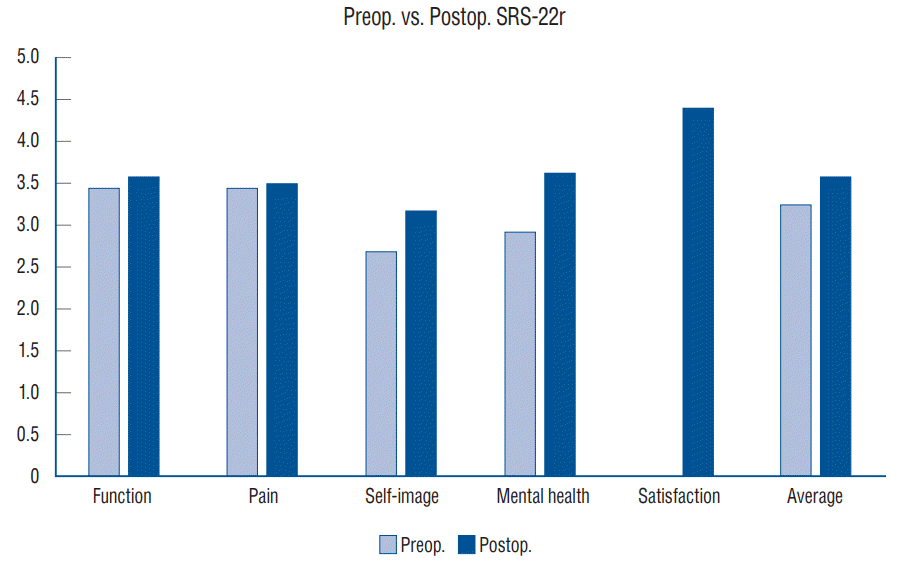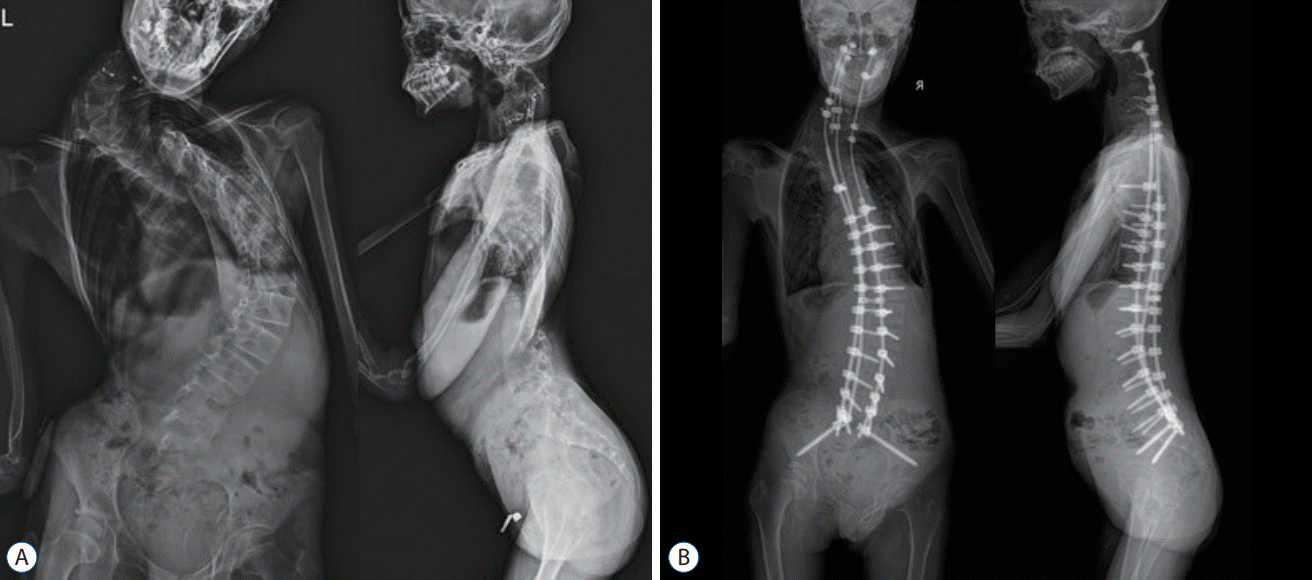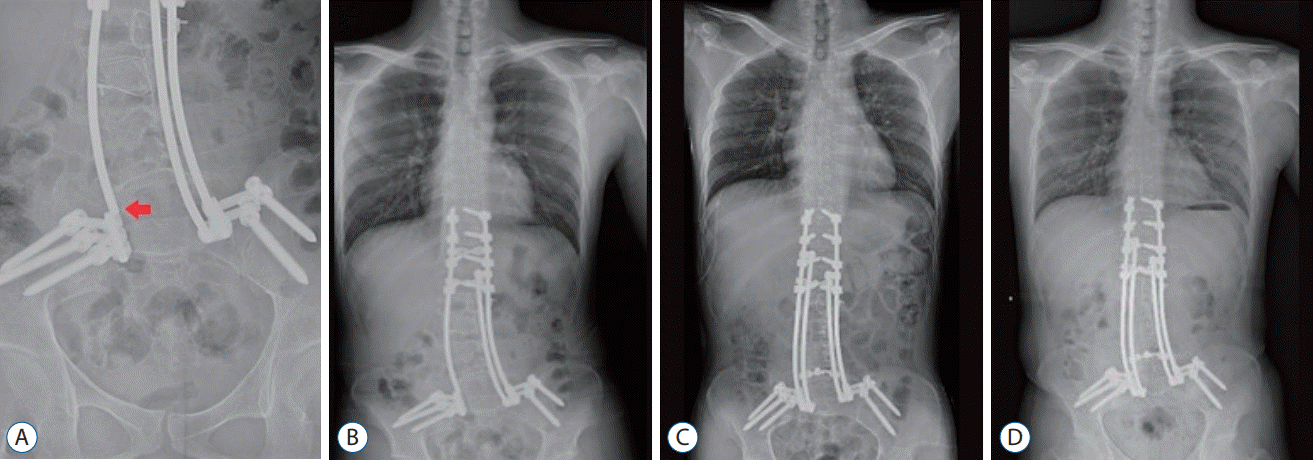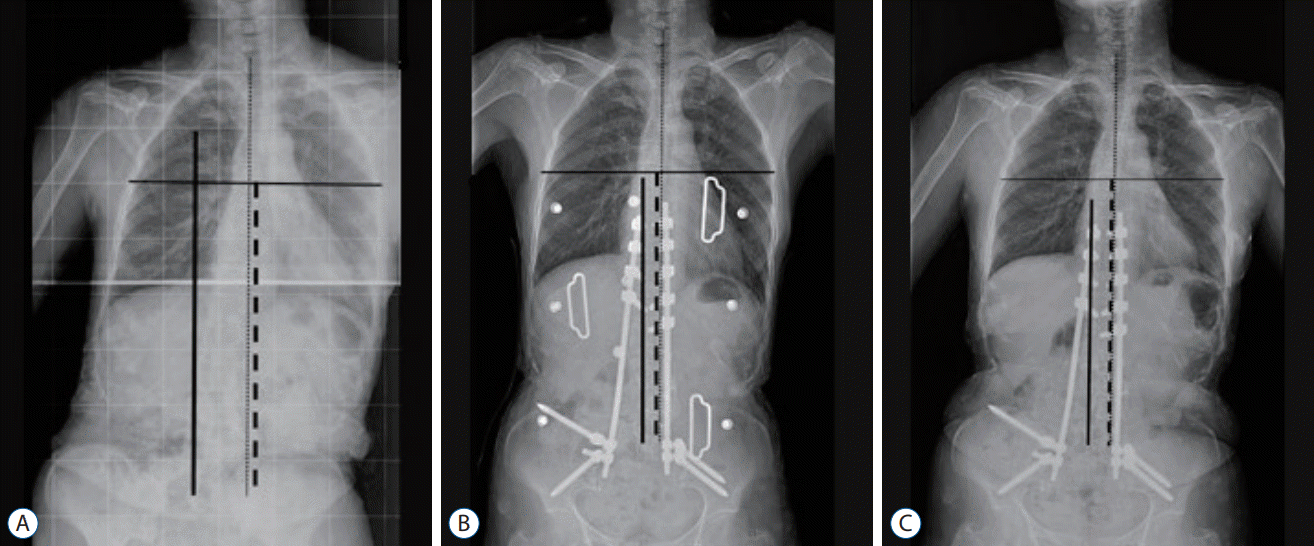1. Bae J, Lee SH. Minimally invasive spinal surgery for adult spinal deformity. Neurospine. 15:18–24. 2018.

2. Crawford AH. Pitfalls of spinal deformities associated with neurofibromatosis in children. Clin Orthop Relat Res. (245):29–42. 1989.

3. Deng A, Zhang HQ, Tang MX, Liu SH, Wang YX, Gao QL. Posterior-only surgical correction of dystrophic scoliosis in 31 patients with neurofibromatosis type 1 using the multiple anchor point method. J Neurosurg Pediatr. 19:96–101. 2017.

4. Durrani AA, Crawford AH, Chouhdry SN, Saifuddin A, Morley TR. Modulation of spinal deformities in patients with neurofibromatosis type 1. Spine (Phila Pa 1976). 25:69–75. 2000.

5. Elefteriou F, Kolanczyk M, Schindeler A, Viskochil DH, Hock JM, Schorry EK, et al. Skeletal abnormalities in neurofibromatosis type 1: approaches to therapeutic options. Am J Med Genet A. 149A:2327–2338. 2009.

6. Halmai V, Domán I, de Jonge T, Illés T. Surgical treatment of spinal deformities associated with neurofibromatosis type 1. Report of 12 cases. J Neurosurg. 97(3 Suppl):310–316. 2002.

7. Hyun SJ, Jung JM. Spinal deformity surgery : it becomes an essential part of neurosurgery. J Korean Neurosurg Soc. 61:661–668. 2018.

8. Hyun SJ, Lee BH, Park JH, Kim KJ, Jahng TA, Kim HJ. proximal junctional kyphosis and proximal junctional failure following adult spinal deformity surgery. Korean J Spine. 14:126–132. 2017.

9. Hyun SJ, Lenke LG, Kim YC, Koester LA, Blanke KM. Comparison of standard 2-rod constructs to multiple-rod constructs for fixation across 3-column spinal osteotomies. Spine (Phila Pa 1976). 39:1899–1904. 2014.

10. Illés T, Halmai V, de Jonge T, Dubousset J. Decreased bone mineral density in neurofibromatosis-1 patients with spinal deformities. Osteoporos Int. 12:823–827. 2001.

11. Iwai C, Taneichi H, Inami S, Namikawa T, Takeuchi D, Kato N, et al. Clinical outcomes of combined anterior and posterior spinal fusion for dystrophic thoracolumbar spinal deformities of neurofibromatosis-1: fate of nonvascularized anterior fibular strut grafts. Spine (Phila Pa 1976). 38:44–50. 2013.

12. Kim HW, Weinstein SL. The management of scoliosis in neurofibromatosis. Spine (Phila Pa 1976). 22:2770–2776. 1997.

13. Kim WB, Park YS, Park JH, Hyun SJ. Posterior spinal reconstruction with pedicle screws, multiple iliac screws and wisconsin spinal wires in a patient with neurofibromatosis scoliosis: a case report. Korean J Spine. 12:181–184. 2015.

14. Koptan W, ElMiligui Y. Surgical correction of severe dystrophic neurofibromatosis scoliosis: an experience of 32 cases. Eur Spine J. 19:1569–1575. 2010.

15. Kurucan E, Bernstein DN, Thirukumaran C, Jain A, Menga EN, Rubery PT, et al. National trends in spinal fusion surgery for neurofibromatosis. Spine Deform. 6:712–718. 2018.

16. Lee BH, Hyun SJ, Kim KJ, Jahng TA, Kim YJ, Kim HJ. Clinical and radiological outcomes of posterior vertebral column resection for severe spinal deformities. J Korean Neurosurg Soc. 61:251–257. 2018.

17. Lykissas MG, Schorry EK, Crawford AH, Gaines S, Rieley M, Jain VV. Does the presence of dystrophic features in patients with type 1 neurofibromatosis and spinal deformities increase the risk of surgery? Spine (Phila Pa 1976). 38:1595–1601. 2013.

18. Makhni MC, Shillingford JN, Laratta JL, Hyun SJ, Kim YJ. Restoration of sagittal balance in spinal deformity surgery. J Korean Neurosurg Soc. 61:167–179. 2018.

19. Merrill RK, Kim JS, Leven DM, Kim JH, Cho SK. Multi-rod constructs can prevent rod breakage and pseudarthrosis at the lumbosacral junction in adult spinal deformity. Global Spine J. 7:514–520. 2017.

20. Ohrt-Nissen S, Dahl B, Gehrchen M. Choice of rods in surgical treatment of adolescent idiopathic scoliosis: what are the clinical implications of biomechanical properties? - a review of the literature. Neurospine. 15:123–130. 2018.

21. Park YS, Hyun SJ. Spinal deformity in neurofibromatosis: classification and management. J Spine. 3:2. 2014.

22. Petramala L, Giustini S, Zinnamosca L, Marinelli C, Colangelo L, Cilenti G, et al. Bone mineral metabolism in patients with neurofibromatosis type 1 (von Recklingausen disease). Arch Dermatol Res. 304:325–331. 2012.

23. Rezaian SM. The incidence of scoliosis due to neurofibromatosis. Acta Orthop Scand. 47:534–539. 1976.

24. Savini R, Parisini P, Cervellati S, Gualdrini G. Surgical treatment of vertebral deformities in neurofibromatosis. Ital J Orthop Traumatol. 9:13–24. 1983.
25. Schindeler A, Ramachandran M, Godfrey C, Morse A, McDonald M, Mikulec K, et al. Modeling bone morphogenetic protein and bisphosphonate combination therapy in wild-type and Nf1 haploinsufficient mice. J Orthop Res. 26:65–74. 2008.

26. Shahcheraghi GH, Tavakoli AR. Corpectomy and circumferential spinal fusion in dystrophic neurofibromatous curves. J Child Orthop. 4:203–210. 2010.

27. Shen JX, Qiu GX, Wang YP, Zhao Y, Ye QB, Wu ZK. Surgical treatment of scoliosis caused by neurofibromatosis type 1. Chin Med Sci J. 20:88–92. 2005.
28. Sponseller P. The spine in skeletal syndromes and dysplasias. In : DeWald RL, editor. Spinal deformities. The comprehensive text. Thieme;New York: 2003. p. 701–717.
29. Trobisch PD, Samdani AF, Pahys JM, Cahill PJ. Postoperative trunk shift in Lenke 1 and 2 curves: how common is it? and analysis of risk factors. Eur Spine J. 20:1137–1140. 2011.

30. Tsirikos AI, Saifuddin A, Noordeen MH. Spinal deformity in neurofibromatosis type-1: diagnosis and treatment. Eur Spine J. 14:427–439. 2005.

31. Wang Z, Fu C, Leng J, Qu Z, Xu F, Liu Y. Treatment of dystrophic scoliosis in neurofibromatosis type 1 with one-stage posterior pedicle screw technique. Spine J. 15:587–595. 2015.

32. Winter RB, Anderson MB. Spinal arthrodesis for spinal deformity using posterior instrumentation and sublaminar wiring. A preliminary report of 100 consecutive cases. Int Orthop. 9:239–245. 1985.

33. Wui SH, Hyun SJ, Kang B, Kim KJ, Jahng TA, Kim HJ. Bicortical screw purchase at upper instrumented vertebra (UIV) can cause uiv fracture after adult spinal deformity surgery: a finite element analysis study. Neurospine. 17:377–383. 2020.

34. Neurofibromatosis. Conference statement. National Institutes of Health Consensus Development Conference. Arch Neurol. 45:575–578. 1988.








 PDF
PDF Citation
Citation Print
Print



 XML Download
XML Download